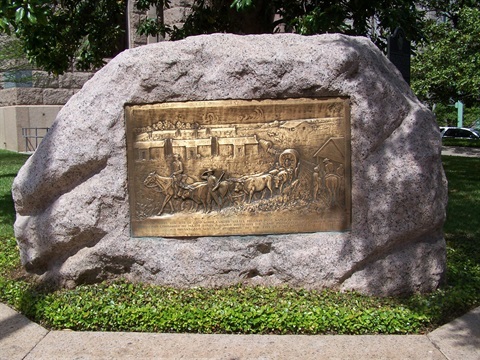Heritage Park

Dedication
Size
Additional amenities
- Benches
- Bike Rack
- Bridge
- Drinking Fountain
- Multi-use/Purpose Slab
- Park Lighting
- Parking Lot
- Pet Station
- Restroom
- Shelter
- Table
Fun Facts and History
The bluff north of the Tarrant County Courthouse has played a unique role in Fort Worth’s history. It was here that the military outpost from which Fort Worth sprang was located. By the turn of the twentieth century, there was a call to preserve the site for its historical importance to the city. Park planners George E. Kessler, S. Herbert Hare, and Lawrence Halprin each designed plans for the development of the bluff but it would not be until the nation’s Bicentennial era that progress was made toward that goal.
A coalition of private and public organizations banned together for the creation of Heritage Park straddling both sides of the Trinity River in the vicinity of the confluence of the West and Clear Forks. Participating organizations included the Amon G. Carter Foundation (who had recently funded the creation of the Fort Worth Water Gardens), the Streams and Valleys Committee, Sid Richardson Foundation, Texas Electric Service Company, the Fort Worth Parks and Recreation Department, Tarrant County, and the Tarrant County Water Control District #1. Following funding approval from the Texas Parks and Wildlife and the Bureau of Outdoor Recreation, park planners felt assured of the park’s creation. Ground was broken for the 113-acre park in January 1976. One of the first things completed was a bike and pedestrian bridge across the river. However, the centerpiece of the park was to be a plaza designed by nationally known landscape architect Lawrence Halprin to be located on the west side of North Main Street and to the north of Paddock Park. Ground for the plaza, designed as a series of outdoor rooms unified by water features, was broken in November 1977. It has been inferred that Halprin’s design for Heritage Plaza was a precursor of his later design for the Franklin Delano Roosevelt Memorial in Washington, D.C. It, too, is notable for its series of rooms that dictate the way in which one experiences the site. The completed park was dedicated on April 19, 1980.
Although the plaza was located along a busy street, its secluded design, deferred maintenance of the water features, and vegetative overgrowth led to the park’s under-utilization. The water features were turned off in 2007. Preservation organizations raised concern that because of its condition, the park was in danger of demolition or heavy alteration. In 2009, a steering committee was formed to investigate its rehabilitation and Laurie Olin was retained to coordinate the study of the park. On May 10, 2010, Heritage Plaza was listed on the National Register of Historic Places for its significance as a designed landscape. A bond election scheduled for 2014 includes $1.5 million dollars for infrastructure improvements at the park.
In the far western end of the park on the levee above the West Fork of the Trinity River is the Haws Athletic Center. This building replaced the Athletic Center that was located in the old Recreation Building at 215 W. Vickery Boulevard. Growald Architects was selected to design the center. The new facility was completed in 1982 and became the headquarters for the Athletic Division. It was named for Charles Haws who was chair of the park board at the time the park and recreation departments were combined in 1964. He served as the new board’s chair until 1965. He died in Winnipeg, Canada in November 1976 at the age of 53.
View animal, plant and insect species observed at Heritage Park and make some of your own observations through iNaturalist. See link under the "Related information" Section.
Reserve this park on ActiveNet
Location
600 Congress St, Fort Worth 76107 View Map
32.76007990000001,-97.3414021
600 Congress St ,
Fort Worth 76107
600 Congress St ,
Fort Worth 76107
Heritage Park
Photo Gallery